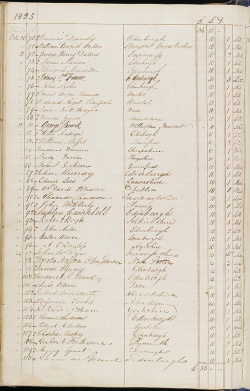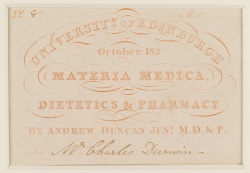Student Records
Our Student Records date from the earliest days of the University. Details follow below. For further information on how to use them as a researcher, please see our Researching Alumni guide.
Central records
The main student records for the University of Edinburgh are listed below. The details of any individual students may occur in one or many of these, depending on what they studied and at period they were at the University. Because, until the mid 19th century in particular, some students did not go through the formalities of matriculation and graduation, there names can be absent from some or all of these records series.
Laureation and Degrees Albums (1587-1896)
Ref. code: EUA IN1/ADS/STA/1
These volumes contain the students signatures, recorded at the time of their graduation.
The First Laureation & Degrees Album is the University's oldest owned record (the foundation Charter belonging to the City of Edinburgh).
Matriculation Albums (1627-1980)

Ref. code: EUA IN1/ADS/STA/2
Although not beginning until 1627 these provide the most comprehensive record of enrolled students. In basic terms they are a list of names of matriculating students at the University of Edinburgh. Throughout most of them (up until about the 1920s) only a signature or name of the matriculating student is recorded. The University of Edinburgh was unique in this process, where only a signature or name was necessary to matriculate. No details were recorded, for example about parentage or date of birth. Occasionally some classes taken by the student, the professor from whom tuition was received or the nationality of the student has been recorded.
Typically they contain:
- matriculation number
- name
- faculty
- place of origin
A manual index (sheaf binders) of names up to 1858 lists names alphabetically, one index for medical students, another for everyone else.
A general overview of changes in content over time follows:
- 1786: A-Z listing within class groupings
- 1807: Completely A-Z with no class groupings
- 1811: Becomes form-based. Matriculation numbers begin with names in numerical order. Place of origin, Faculty and year of study recorded.
- 1865: Age next birthday added.
- 1898: Home address added.
- 1923: Degree/Diploma added
Matriculation Indexes and Class Lists (1783-1986)
Parallel volumes up to 1810
- General: 1791-1810
- Medical: 1783-1810
Students listed A-Z within classes.
Thereafter General and Medical in the same volumes. Content over time:
- 1811: Matriculation number included.
- 1836: Index to each volume.
- 1894: Becomes solely an index to names in Matricluation albums.
First Matriculation (1869-1961)
Beginning in 1869, these are the most comprehensive records of student enrolment from then on. These form-based schedules are tied to the Matriculation Albums via the matriculation number but (normally) only cover the first year of a student’s study in any one course. In subsequent years of study, students were given a new matriculation number each year.
A general overview of changes in content over time follows: From 1869/70:
- Name in full
- Birthplace
- Age last birthday
- Faculty/Faculties of proposed study
- School education
- Previous medical education (3 categories)
- Previous university education (4 categories)
(page annotated with matriculation number but not within form)
In addition from 1873/74:
- Matriculation number integrated with rest of form
In addition from 1875/76:
- Previous medical education changed to Previous medical education other than University education (still with 4 categories)
In addition from 1884/85:
- Of what country
In addition from 1894/95:
- Of what religious denomination added
- Birthplace becomes Birthplace (Town or parish etc.)
1920-21 - various changes, resulting in:
- Matriculation number (number of signature in album)
- Name in full
- Addresses – Edinburgh; Permanent
- Name and address of nearest relative and relationship
- Birthplace (Town or parish)
- Of what country (nationality)
- Of what religious denomination
- Age last birthday
- Faculty or Faculties of proposed study (if Science, state dept.)
- Date and number of Scottish Universities Entrance Board cert.
- School Education
- Previous University Education (4 categories)
- Previous medical (other than University )education
In addition from 1921/22:
- Previous OTC training (continues until 1930/31)
In addition from 1928/29:
- Various questions relating to sports and sporting achievements (continues until
1930/31)
Graduates in Arts (under new ordinances) (1893-1966)
Prior to 1893, Arts graduates are recorded only in the Laureation and degrees albums. However, from 1893 onwards a forn-based schedule was created recording the courses completed and marks awarded that made up the degree completed.
For non-graduating students, i.e. those who withdrew or failed, there is a parallel series of records.
Graduates in Education (1914-1947)
Graduates in Law (1914-1947)
Graduates in Medicine (1833-1959)
Medicine was the first Faculty to record details of students marks and achievments, creating schedules of these for each student. Beginning in simple handwritten format, these become quickly regularized through the use of dedicated forms.
Graduates in Science (1899-1965)
Prior to 1893, Science graduates are recorded only in the Laureation and degrees albums. From 1983-1898, prior to the creation of a separate Faculty of Science, Science graduates are recorded under Arts (see section above). Thereafter separte schedules exist for Science graduates, recording the courses completed and marks awarded that made up the degree completed.
For non-graduating students, i.e. those who withdrew or failed, there is a parallel series of records.
Other records
Professor's and Departmetal Class Lists
These are less 'official' rcords, kept in a less regularised way by individual Professors or departments. Survival of these is ad hoc.
As well as having a specific collection of these type of records, others can be found within the records of the department concerned and sometimes even within a Professor's own papers. The can, in the earlier period, record students who had not formally matriculated and are therefore absent from the central records. However because these are not regularised in format, nor, in most cases, indexed, locating specific names can be a burdensome process.
Class Cards and Certificates

These were the things issued to students when they enrolled in classes or at graduation. As such the ones we have are only the ones we have acquired by gift or purchase.